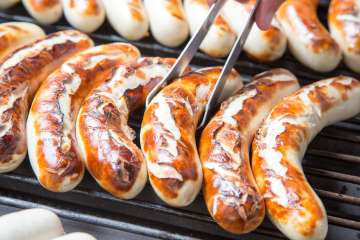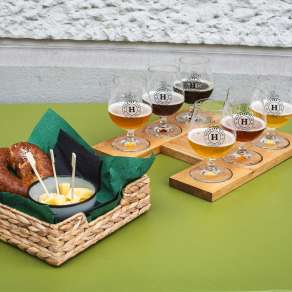Bratwurst, Bürli, Bier & Biber

The «4 B culinary highlights of St.Gallen»
Culinary delights are a tradition in St.Gallen. The St.Gallen bratwurst is an authentic dish that tastes simply perfect when served with a crispy «Bürli» and a glass of locally brewed beer. For a sweet finishing touch, try the «Biber», a traditional almond pastry. Immerse yourself in the diversity and authenticity of St.Gallen cuisine!
All versions without mustard
1. St.Gallen bratwurst
The recipe for the sausage first appeared in the statutes of the St.Gallen butchers' guild in 1438. To this day, the production of this fine product must adhere strictly to regulations in order to earn the honourary title of «St.Gallen Bratwurst IGP». IGP stands for Indication Géographique Protégée. This means that this wholesome delicacy is virtually a protected cultural asset, as genuine St.Gallen Bratwurst may only be produced in the region, with all ingredients sourced from Switzerland. The basis is formed by veal, pork and bacon. The mixture is combined with milk, which gives the bratwurst its distinctive white colour. It is seasoned with salt, pepper and marcis (grated nutmeg). Other spices may be added for refinement in accordance with strict regulations, but they are not essential.
The classic St.Gallen bratwurst weighs between 110 and 130 grams. Those who prefer a larger bratwurst can opt for the «OLMA Bratwurst», which weighs around 160 grams and is named after the famous OLMA trade fair in St.Gallen. A particularly fine variety is «The Noble One», which has a higher veal content. The «St.Gallen Kinderfest Bratwurst» is the superstar of bratwursts, weighing an impressive 220 grams and produced only every three years for the «Kinderfest». No matter which variety you choose, enjoy it without mustard!


Water as a secret
2. St.Galler Bürli
The «Bürli» is a small farmhouse bread with a crispy crust. Inside, it has a pleasantly light and fresh dough. It is made with just flour, water, yeast, malt and salt. «God preserve it», one might say, given its simplicity. Despite its simple ingredients, however, the «Bürli» has always been something special. From the very beginning, it was considered a delicacy. A chronicle from 1723 reports: «As a sign of prosperous times, «Bürli» made from the finest schiten flour are served with beer and wine in restaurants.» At that time, the small, crispy bread was mostly produced and served in wealthy areas. This was also the case in St.Gallen, a city that had become wealthy through the production and sale of embroidered goods, among other things.
The secret to this delicious baked good is its high water content. The «Bürli» consists of roughly equal parts flour and water. This creates a very soft dough, which must be left to rest overnight. The next day, salt, malt and fresh yeast are added. The well-kneaded dough is then left to rest for another hour. After that, under no circumstances must it be kneaded again. This would destroy the air pockets inside. This is what makes a «Bürli» taste so fluffy, fresh and delicate on the inside. The crispy crust is created by baking at a high temperature.
Calmness is the key to the taste
3. St.Gallen beer
Beer brewing has a long tradition in St.Gallen. The monastery is responsible for this, in a positive sense. Its monks were pious and godly, but also quite thirsty. Beer was produced on a large scale here as early as the 11th century. There were no other breweries of this size in Europe at that time. In the hope that God would bless the beer, the monks built the granary in the shape of a cross.
The Schützengarten brewery also has a long history. Johann Ulrich Tobler founded the business in St.Gallen in 1779. Since then, the brewery has always remained privately owned by the same family. The Schützengarten brewery produces a wide range of beers. But all varieties share a secret. Beers produced quickly are on the market within two to three weeks. Beers from the Schützengarten brewery are stored for at least eight weeks until they have reached full maturity. This is what gives it its unique flavour. So reach for a glass of Schützengarten beer and savour the finest Swiss brewing tradition, sip by sip.


A gingerbread with character
4. St.Galler Biber
Don't worry, the people of St.Gallen aren't out to get these cute little animals. Instead, they serve up a sweet treat that you'll love. The «Biber» is a gingerbread biscuit made from honey dough and filled with almond paste. It was originally called «Birnenzelten». Over the years, this evolved into «Biberzelten», and eventually the name shortened to «Biber», becoming well known far beyond the borders of St.Gallen.
The tops of the «Biber» are decorated with miniature works of art. In the past, hand-carved templates were pressed into the soft dough. Popular motifs included St.Gallen Cathedral and an upright bear, which is the city's symbol. Today, the «Biber» is often decorated with images printed on marzipan. Food colouring is used, so you can literally let the art melt in your mouth. Biber are available in various sizes, making them an ideal tasty souvenir.
Ready for the 4 B St. Gallen culinary highlights?
The «4 B St.Gallen culinary highlights» offer plenty of variety. Of course, you are free to round off your culinary adventure with a glass of wine or a spicy liqueur. Alternatively, you could specialise in individual stages, such as expanding your beer tasting to include a more in-depth study of different types. Alternatively, you could start a circuit training programme and begin again from the beginning. After all, those who never enjoy themselves will eventually become unpalatable. With this in mind, «en Guete»!












